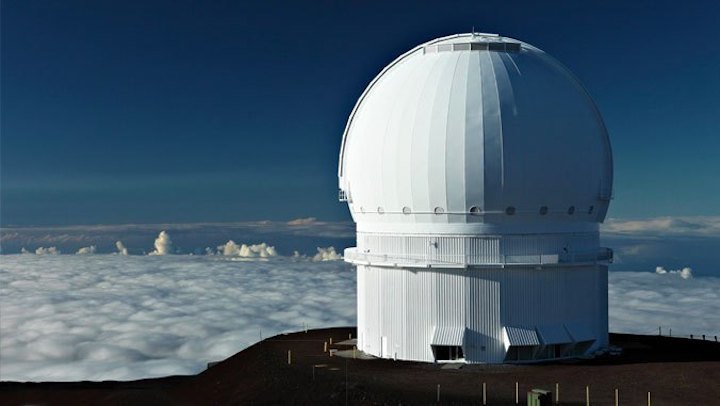12.08.2019

HILO, HI – After a four-week suspension of work at the summit of Maunakea, the existing telescopes will attempt a return to operations.
“The Maunakea Observatories represent an invaluable sector for Hawai‘i Island and our entire State – the economic impact, intellectual capital, educational resources and community support they provide is irreplaceable,” said Governor David Ige, State of Hawai‘i. “The interim solution for access to the telescopes is a step forward but remains inadequate for the long term. The State remains committed to re-opening the Maunakea Access Road intersection as an immediate priority. The State stands behind the more than 500 employees’ efforts to bring the telescopes back online to begin astronomical observations again.”
The Maunakea Access Road remains blockaded. However, activists agreed, after the Emergency Proclamation was withdrawn, to allow all existing observatory employees, including astronomers, to access Maunakea using the Old Saddle Road and a section of unpaved lava. This route is unimproved and lined with tents, cars and people. However, pursuant to this agreement, on Wednesday, August 7, 2019 the State laid cinder and cones in an attempt to address safety concerns. The people blocking the road also agreed to allow larger vehicles to access Maunakea by going around the tent blockade. This means the vehicles will travel on the road’s shoulder.
The current process of gaining access to Maunakea requires the observatories to provide prearranged notification of all vehicles seeking access. To accomplish this, the people blocking the road will be provided a list of which vehicles are going up and when. This requires the observatories to contact the Office of Maunakea Management, which then contacts law enforcement, who then provides the list to the activists. The observatories are also aware that activists have been keeping a log of who goes up and down.
This arrangement — and the improvements made by the state to address safety concerns and ensure appropriate access for the observatories — constitutes progress. The observatories hope this process will allow them to return to as close to full operations as possible while the Maunakea Access Road remains blocked. However, the state, county and observatories remain committed to reopening the blocked Maunakea Access Road intersection to vehicular traffic so that access will be unimpeded and prior notification and/or approval by the protesters will no longer be necessary.
“This is what we have all been collectively working on: protecting the rights of the protectors to demonstrate is our responsibility; protecting the rights of the workers at the observatories to go up the mountain to do their work is our responsibility; and protecting the rights of the public to visit the mountain is our responsibility,” said Mayor Harry Kim, County of Hawai‘i. “We’re very appreciative of the efforts by DOCARE to negotiate with the protectors to regain access. This is a step forward, but still my goal is to open the mountain in protection of the rights of all others.”
The Observatories plan to send regular day crews back to the summit to prepare the telescopes to resume operations. During the prolonged shutdown, some instruments and systems were disabled to protect the health of the technology, so the restart process will vary in complexity from telescope to telescope. The Observatories hope to resume scientific observations as soon as possible.
“The Maunakea Observatories thank the state and county for their statements of support for a continued vibrant astronomy sector in Hawai‘i,” said Hilton Lewis, director of the W. M. Keck Observatory. “We are deeply committed to our community here on Hawai‘i Island and are eager to get back to work at our telescopes as soon as possible, to resume the world-leading astronomy for which Hawai’i is renowned.”
This four-week suspension has been the longest period of time in the five-decade history of Maunakea astronomy that all telescopes have been simultaneously offline. Observatory employees — technicians, astronomers, instrument scientists and engineers alike — eagerly anticipate a return to the daily work they love. The international community, of which these telescopes are a part, also eagerly awaits the return of their vital partner.
About the Maunakea Observatories
The Maunakea Observatories are a collaboration of independent institutions with telescopes located on Maunakea on the island of Hawai’i. Together, the Observatories make Maunakea the most scientifically productive site for astronomy world-wide. The Maunakea Observatories include: Caltech Submillimeter Observatory, Canada-France-Hawai’i Telescope, Gemini International Observatory, James Clerk Maxwell Telescope (EAO), NASA Infrared Telescope Facility, Subaru Telescope, Submillimeter Array, United Kingdom Infrared Telescope, University of Hawai’i Hilo Educational Telescope, University of Hawai’i 2.2 Meter Telescope, Very Long Baseline Array, W. M. Keck Observatory (Keck I and Keck II telescopes).
Quelle: W. M. Keck Observatory
----
Update: 13.08.2019
.
Critical observation made on Maunakea during first night of return to operations

Canada-France-Hawaii telescope
The existing astronomical observatories on Maunakea returned to operations this weekend, and it didn’t take long for a significant result to be achieved, not only for science, but for assuring the safety of the Earth.
Observations of the near-Earth asteroid 2006 QV89 made on August 11 with the Canada-France-Hawaii Telescope (CFHT) have ruled out any potential future impact threat to the Earth by this asteroid for the next century.
2006 QV89 was discovered on August 29, 2006, with a telescope in Arizona, and observations were only possible through September 8, 2006, when the asteroid became unobservable from telescopes on Earth. The orbit determined from these limited observations had significant uncertainty, and it was not possible to rule out the low probability of the asteroid impacting Earth in the future, possibly as early as 2019. Last month, observations with the European Southern Observatory’s (ESO) Very Large Telescope(VLT) in Chile did not find the asteroid where it would have appeared if it was on a trajectory that would impact Earth this September. This ruled out an impact in 2019, but an impact for 2020 remained a possibility, along with nearly two dozen more over the next hundred years, with eight of those in the next decade.
“There is a big difference between knowing where a hazardous asteroid isn’t, and knowing where it is,” said David Tholen, astronomer at the University of Hawaiʻi’s Institute for Astronomy, who led the effort to recover 2006 QV89.
This summer provided the first clear opportunity to recover the asteroid since its discovery, but the uncertainty in its position on the sky spanned roughly 30 degrees (60 times the diameter of the moon) in mid-July, growing even larger as the asteroid approached the Earth. “That made the use of a large telescope with a wide-field camera absolutely essential,” noted Tholen. Only a fraction of that uncertainty region had been imaged with CFHT on July 14, but operations at the existing telescopes were suspended on July 16, due to the protest on Maunakea.
“We found at least a dozen asteroids in the July 14 data that fell close to the region where 2006 QV89could have been, but the suspension of operations prevented us from confirming which, if any, of those objects was 2006 QV89,” said Tholen.
Aid from UH graduate
With access to the Maunakea telescopes blocked, Tholen enlisted the aid of Marco Micheli of the European Space Agency’s NEO Coordination Centre in Frascati, Italy. Micheli is a UH graduate who led the effort to rule out the 2019 impact scenario with ESO’s VLT. He pointed a telescope in Spain at the position for the best of the candidate objects, but after two hours of data collection, the object at the predicted position could not be convincingly distinguished from electronic noise in the data. It came as a great relief to learn that CFHT would resume operations last weekend.
“Our highest priority target for Saturday night was the best 2006 QV89 candidate, and despite some thin cirrus clouds and a lot of moonlight, we needed only four minutes of data to obtain proof that we had found the right object,” said Tholen.
Results and relief
The International Astronomical Union’s Minor Planet Center announced the recovery to the world on Sunday, and the impact monitoring services at the Jet Propulsion Laboratory and the University of Pisa/SpaceDys in Italy immediately began crunching the numbers to update the impact predictions. A little over an hour later, Davide Farnocchia of Center of Near-Earth Object Studies at NASA’s Jet Propulsion Laboratory in Pasadena reported that all the impact scenarios for the next century had been eliminated.
“This result is only one example of the telescopes on Maunakea protecting Earth by observing and studying the asteroids that enter Earth’s neighborhood,” said Kelly Fast, manager of the Near Earth Object Observations Program in NASA’s Planetary Defense Coordination Office, which supported the observations.
Much in the same way that meteorologists use weather satellite imagery to track hurricanes to determine whether they represent a hazard to people and property, astronomers use telescopes to track asteroids near the Earth to determine whether they represent an impact hazard. “A different asteroid, 2019 NX5, got away from us while the Maunakea telescopes were shuttered, which is regrettable,” Tholen said. “We are relieved that we were able to catch 2006 QV89 before our window closed. We are even more relieved that it won’t impact the Earth.”
Quelle: University of Hawaiʻi
